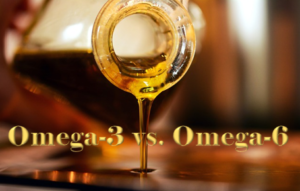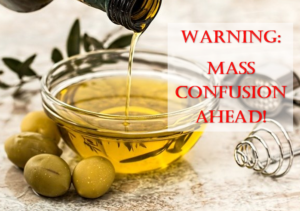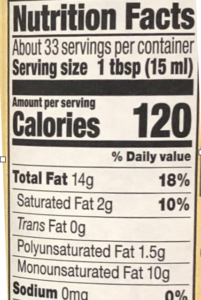It seems like such a simple question:
“What is the best oil to use?”
Have you looked at all the choices at the store lately? There is olive oil, coconut oil, walnut oil, peanut oil, avocado oil, sesame oil, grapeseed oil, canola oil, and the list goes on!
These oils are not created equal, especially when it comes to how they are processed, their sensitivity to heat, and how they affect our health.
Join me on a visit to the oils section of the grocery store to navigate all the choices…and learn what we do!
Here is some more information to keep in mind:
Processing matters!
 Oils are extracted from the plants, fruits, nuts or seeds using one of three main methods:
Oils are extracted from the plants, fruits, nuts or seeds using one of three main methods:
- Cold-pressed: uses mechanical processes to press the oils from their source. This method is performed in a temperature controlled environment so the oils aren’t damaged. To be officially certified “extra virgin,” an olive oil must be cold-pressed.
- Expeller-pressed: this method is similar to cold-pressing, but the temperature is not controlled. The higher heat can result in some loss of nutrients, so this method is better than refined oils but not as good as cold-pressed in terms of health benefits.
- Refined: this method typically uses chemicals or solvents to extract the oils. This method produces high volumes of oil that have a longer shelf life, higher smoke point, neutral taste and aroma, and are less expensive. This process also retains the least amount of nutrients. When it comes to olive oil, if it says “pure olive oil” or “light olive oil,” there is a good chance it is highly refined. Make sure to read those ingredient labels!
Can they handle the heat?
Oils react differently to heat, depending on the types of fat they contain and how much they have been processed. Some oils can lose their health benefits by “oxidizing” when heated, meaning they form free radicals and other compounds that can damage healthy cells. If heated too much or for too long, it can also result in an unpleasant taste or odor. You will read a lot that this is related to the oil’s “smoke point,” but it is not that simple, as there are other factors that affect an oil’s stability and safety when it is heated.
 Oils with high saturated fats, such as coconut oil, tend to hold up well to heat.
Oils with high saturated fats, such as coconut oil, tend to hold up well to heat.- Oils that are higher in monosaturated fats, like extra virgin olive oil and avocado oil, also do well with medium heat and even some higher-heat cooking. This study found that extra-virgin olive oil was the safest and most stable among ten common cooking oils when heated to temperatures even higher than those commonly used for sautéing and roasting. And, remember, monounsaturated fats are associated with a number of health benefits, including helping to increase your good cholesterol (HDL) and lowering your bad cholesterol (LDL), as well as having favorable effects on your blood sugar and blood insulin.
- Oils that are high in polyunsaturated fats are more easily damaged by heat and oxygen. Walnut oil and flaxseed oil are a couple examples of oils that should not be used in cooking and are actually best stored in the refrigerator. Other oils high in polyunsaturated fats include corn oil, grapeseed oil, safflower oil, soybean oil and sunflower oil…these oils are often refined, meaning they can be used for higher-heat cooking, but the refining process has also stripped them of much of their health benefits, flavor and aroma.
Balance is Key for Omega-6 and Omega-3!
 Omega-6 and omega-3 fatty acids are polyunsaturated fats found in oils (and other foods) that are “essential” to our well-being: our bodies cannot make them, so we have to get them through our diets. While both types are important, it’s critical to consume these omega fats in the right balance.
Omega-6 and omega-3 fatty acids are polyunsaturated fats found in oils (and other foods) that are “essential” to our well-being: our bodies cannot make them, so we have to get them through our diets. While both types are important, it’s critical to consume these omega fats in the right balance.
The ideal ratio of omega-6 to omega-3 is 2:1 or 1:1, but the standard American diet can be as high as 15:1…or even higher! This imbalance can lead to inflammatory diseases including cardiovascular disease, type 2 diabetes, asthma, rheumatoid arthritis, various forms of cancer and irritable bowel syndrome, to name a few.
The reason for this imbalance is typically processed foods and fast foods, many of which contain inexpensive and readily available oils with high amounts of omega-6 and little or no omega-3 fats. You can pick up a box of almost anything processed and find at least one of these:
Safflower oil has 75% omega-6 with no omega-3
Grapeseed oil has 70% omega 6 with virtually no omega-3
Sunflower oil has 65% omega-6 with no omega-3
Corn oil has 54% omega-6 with virtually no omega-3
Cottonseed oil has 52% Omega-6 with virtually no Omega-3
Soybean oil has 51% omega-6 with only 7% omega-3
So, what do we do?
The question of the “best oil to use” fuels a lot of different perspectives and opinions. And, let’s face it, there are plenty of conflicting messages. So, amongst all the confusion, we have tried to simplify our approach:
 We prefer to use cold-pressed and expeller-pressed oils whenever possible.
We prefer to use cold-pressed and expeller-pressed oils whenever possible.- For salad dressings and dips where no heat is involved, our “go to” is extra virgin olive oil, and we also like to mix up the flavors with other oils such as cold-pressed walnut, flaxseed, pistachio and macadamia nut oils.
- For everyday cooking (medium heat), we also use extra virgin olive oil. This includes sautéing and roasting.
- For higher heat cooking (like grilling and longer duration roasting), we often use avocado oil, coconut oil or organic expeller-pressed canola oil. While canola oil has a reputation for being unhealthy, it actually has a great fatty acid profile…it is rich in monounsaturated fat and has a good omega-6 to omega-3 ratio. If you can find organic expeller-pressed canola oil, it can be a good (and often less expensive) option for higher heat cooking.
- When a solid fat is needed in snacks or baked goods, such as in the Chocolate Peanut Butter Cups, Strawberry Pie with Walnut Oat Cookie Crust, or Chocolate Chia Energy Bites, unrefined coconut oil is our preferred choice. You won’t find us going too crazy with it, because it is higher in saturated fat, but certainly, this has a place in a healthful, real food diet!
- For Asian dishes, toasted sesame oil adds excellent flavor, and is best added at the end to avoid high heat.
We hope this helps, and we hope you are enjoying the grocery store tours!
As always, please let us know what you would like to see, and please share your stories and experiences with the Eat REAL America community!
 LEARN MORE ABOUT THE NAPKIN!
LEARN MORE ABOUT THE NAPKIN!



Excellent job Krista! You do a fabulous job of simplifying the complex, down to…”at the end of the day, here’s what we use.” I’m so proud to be in partnership with you, helping our members navigate eating REAL for their health!
Thank you so much – right back at ya partner! So grateful for you!
I have a bottle of Extra Virgin Olive Oil but it doesn’t say if it is cold pressed. It also says it contains only 20% olive oil and a mix of Italian Sunflower oil. How does that figure? Violi is the brand.
Well, that is the beauty of reading the ingredient label, for what it’s worth! That is most likely why it doesn’t say cold pressed, because it probably contains mostly refined sunflower oil and only 20% extra virgin olive oil. Now you know what to look for — thank you for sharing! Those sneaky food companies! 🙂
Great video! There were several “I never knew that!” moments. I just happened to find 100% pure cold-pressed avocado oil at Aldi’s yesterday and will give that a try soon.
I noticed that the can of organic extra virgin olive oil spray that I have has no propellants but does contain organic soy lecithin as a non-stick agent. Is that okay or something else to avoid?
Thank you! So glad this was helpful! Regarding the soy lecithin, from what Zonya and I have read and researched is that it is OK — it is used as an emulsifier or lubricant, and used in small amounts. Plus, the fact that your version is organic means it is not genetically modified, which is good. As long as you don’t have a soy allergy or adverse reactions to it, we believe it is generally a safe food additive. Hope that helps and thank you so much for asking!
That does help–thanks!!
You are simply amazing. I love these grocery videos. I wish I lived close by to come grocery shopping with you.
Shideh – I agree, how fun would that be?! Thank you for the encouraging feedback, I appreciate you so much!
This was SOOO helpful. This whole topic has always been confusing to me, and you did a magnificent job of laying it out in a clear and understandable way! Thank you so much for teaching our family how to make better choices about what we eat – and why!!
Thank you so much!